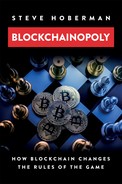Transparency

In many markets, utilities are some of the last true monopolies. We turn on lights, computers, and appliances, and receive our monthly electric or gas bill. However, just as phone companies blossomed in the late 1980s, regulations are now opening the utility market to more companies. New technologies (like smart meters, blockchain, and IoT sensor readings) combined with the availability of alternate energy sources (such as sun and wind), are lowering entry costs for these companies to compete, giving consumers many more diverse energy choices.
A blockchain application can store information provided by sensors that precisely measure how much energy is being used and when the energy is being consumed. This will aid the consumer in making intelligent energy selection choices, with full knowledge of factors such as cost and source.
Streamlining

When a device in a utility’s network breaks, it is frequently reported by the person or organization who is immediately impacted by the loss of service. If a tree falls taking down electrical wires, for example, usually it is up to the homeowner impacted by the fallen tree to report the outage.
If we could combine IoT sensor technology with blockchain, however, the device in need of repair (or nearby devices) could initiate a smart contract to record the trouble ticket. Blockchain would be used as a decentralized ledger where devices in disperse geographic areas could write to it, and consumer representatives and maintenance crews could react.
The startup Filament does this today by installing sensor devices on power poles in the Australian outback. A falling pole “notifies” the next pole using a motion sensor. If that pole does not record the activity in the ledger, the next pole will record it, and so on—for up to ten miles away. With tens of thousands of smart poles collecting data through numerous sensors and communicating that data to another device, the blockchain application continuously tracks everything.26
Privacy

I own an electric car, and the process of charging it when I travel is not always easy or private. I sometimes feel that when I plug in the charger, “Big Brother” is watching and knows exactly where I am. Sure, I sometimes keep Location Services on in my phone, but sometimes it is nice not to be tracked.
With blockchain, the account information when charging can be kept encrypted. Therefore, cars can be charged without divulging private information such as identification or location.
Permanence

Sensor and other IoT readings can be stored in blockchain. Because the data is immutable, scientists and environmental groups can more easily track long-term changes in the environment.
In addition, smart contracts can trigger alerts. For example, if the ozone layer over a particular area becomes less than a certain thickness, an emergency alert will automatically be sent to a government official.
Being immutable and being factual means it might be easier to gain support from citizens and politicians for environmental initiatives.
Distribution

The transparency example at the start of this chapter explored consumers having more choices in energy providers. Here we explore the process from the energy provider perspective.
It is possible that with a blockchain application, anyone with a source of power can feed the grid. For example, a homeowner with solar panels on their roof can “sell” their excess electricity to the grid. The selling and accounting would be performed in blockchain.
Solar Change is doing this today by offering their own currency, SolarCoins, in exchange for energy. Brooklyn Microgrid is also doing something similar, with a community microgrid. This will allow residents to buy and sell energy they produce from rooftop solar power installations, using the existing energy infrastructure and the blockchain ledger for recording and accounting purposes.27
